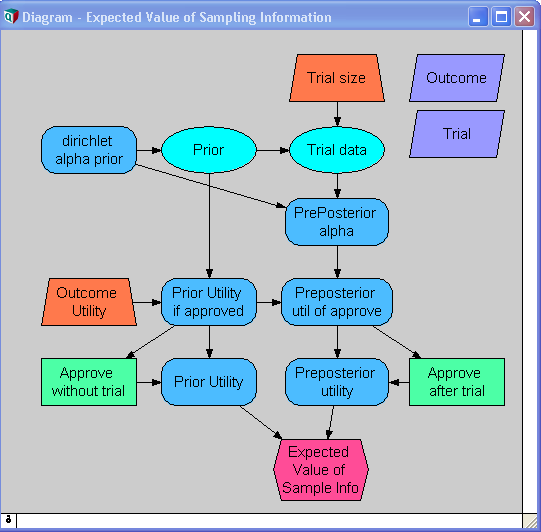In
decision theory
Decision theory (or the theory of choice; not to be confused with choice theory) is a branch of applied probability theory concerned with the theory of making decisions based on assigning probabilities to various factors and assigning numerical ...
, the expected value of sample information (EVSI) is the expected increase in utility that a decision-maker could obtain from gaining access to a
sample
Sample or samples may refer to:
Base meaning
* Sample (statistics), a subset of a population – complete data set
* Sample (signal), a digital discrete sample of a continuous analog signal
* Sample (material), a specimen or small quantity of so ...
of additional observations before making a decision. The additional information obtained from the
sample
Sample or samples may refer to:
Base meaning
* Sample (statistics), a subset of a population – complete data set
* Sample (signal), a digital discrete sample of a continuous analog signal
* Sample (material), a specimen or small quantity of so ...
may allow them to make a more informed, and thus better, decision, thus resulting in an increase in expected utility. EVSI attempts to estimate what this improvement would be before seeing actual sample data; hence, EVSI is a form of what is known as ''preposterior analysis''. The use of EVSI in decision theory was popularized by
Robert Schlaifer and
Howard Raiffa
Howard Raiffa (; January 24, 1924 – July 8, 2016) was an American academic who was the Frank P. Ramsey Professor (Emeritus) of Managerial Economics, a joint chair held by the Business School and Harvard Kennedy School at Harvard University. He ...
in the 1960s.
Formulation
Let
:
It is common (but not essential) in EVSI scenarios for
,
and
, which is to say that each observation is an unbiased sensor reading of the underlying state
, with each sensor reading being independent and identically distributed.
The utility from the optimal decision based only on the prior, without making any further observations, is given by
:
If the decision-maker could gain access to a single sample,
, the optimal posterior utility would be
:
where
is obtained from
Bayes' rule
In probability theory and statistics, Bayes' theorem (alternatively Bayes' law or Bayes' rule), named after Thomas Bayes, describes the probability of an event, based on prior knowledge of conditions that might be related to the event. For exampl ...
:
:
:
Since they don't know what sample would actually be obtained if one were obtained, they must average over all possible samples to obtain the expected utility given a sample:
:
The expected value of sample information is then defined as
:
Computation
It is seldom feasible to carry out the integration over the space of possible observations in E
SIanalytically, so the computation of EVSI usually requires a
Monte Carlo simulation
Monte Carlo methods, or Monte Carlo experiments, are a broad class of computational algorithms that rely on repeated random sampling to obtain numerical results. The underlying concept is to use randomness to solve problems that might be determ ...
. The method involves randomly simulating a sample,
, then using it to compute the posterior
and maximizing utility based on
. This whole process is then repeated many times, for
to obtain a
Monte Carlo sample of optimal utilities. These are averaged to obtain the expected utility given a hypothetical sample.
Example
A regulatory agency is to decide whether to approve a new treatment. Before making the final approve/reject decision, they ask what the value would be of conducting a further trial study on
subjects. This question is answered by the EVSI.

The diagram shows an
influence diagram
Influence or influencer may refer to:
*Social influence, in social psychology, influence in interpersonal relationships
** Minority influence, when the minority affect the behavior or beliefs of the majority
*Influencer marketing, through individ ...
for computing the EVSI in this example.
The model classifies the outcome for any given subject into one of five categories:
:
And for each of these outcomes, assigns a utility equal to an estimated patient-equivalent monetary value of the outcome.
A decision state,
in this example is a vector of five numbers between 0 and 1 that sum to 1, giving the proportion of future patients that will experience each of the five possible outcomes. For example, a state
 The diagram shows an
The diagram shows an  The diagram shows an
The diagram shows an